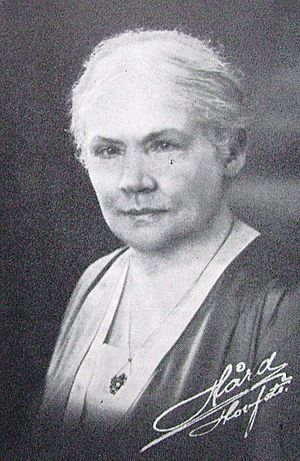Alexandra Skoglund facts for kids
Quick facts for kids
Alexandra Skoglund
|
|
|---|---|
 |
|
| Born | 22 October 1862 Klara Church Parish |
| Died | 12 February 1938 Sankt Matteus |
| Resting place | Norra begravningsplatsen |
| Alma mater | Uppsala University |
| Occupation | Women's rights activist, teacher, historian |
| Employer | |
| Parent(s) | |
Louise Sophie Alexandra Skoglund (1862–1938) was a Swedish activist and politician. She worked hard to gain rights for women. This included the right to vote, which is called suffrage.
Contents
Early Life and Education
Alexandra Skoglund was born on October 22, 1862, in Stockholm, Sweden. She studied at a special school for teachers. This school was called Högre lärarinneseminariet. She graduated from there in 1883.
A Career in Teaching
After finishing her studies, Alexandra became a teacher. She taught at the Åhlinska skolan from 1912 to 1933. She spent many years helping students learn and grow.
Fighting for Women's Rights
Alexandra Skoglund was a very important person in the fight for women's rights in Sweden. She believed that women should have the same rights as men.
The Push for Women's Vote
In 1902 and 1903, Alexandra helped start a group. This group was called the National Association for Women's Suffrage. Its main goal was to get women the right to vote.
At first, this group tried to stay neutral in politics. This meant they did not support any one political party. However, in 1911, the conservative Moderate Party was the only party still against women voting.
Forming a New Suffrage Group
Because of this, Alexandra and other suffragists from the right-wing side decided to form a new group. They created the Moderate Association for Women's Suffrage. This group continued to work for women's voting rights.
A Leader in Politics
Alexandra Skoglund also became a leader in the Moderate Party. She was the chairperson of the women's group within the party. She held this important role from 1920 until 1938.
Later Life and Legacy
Alexandra Skoglund passed away on February 12, 1938. She died in Stockholm, Sweden, at the age of 75. Her work helped change Sweden for the better. She played a big part in making sure women had a voice in their country's future.

